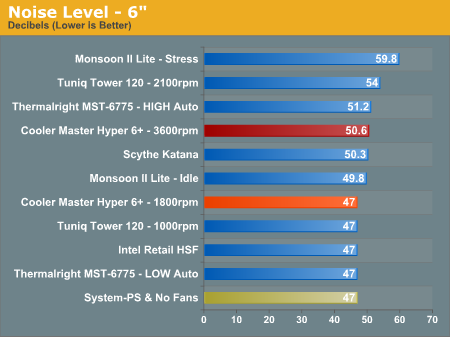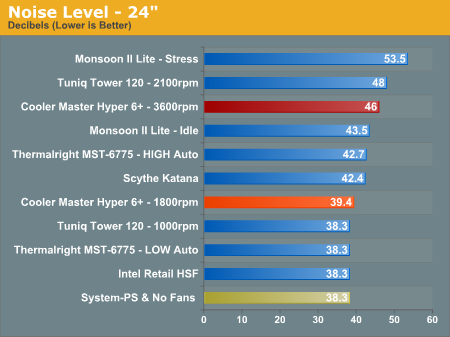Cooler Master Hyper 6+: Universal Heatpipe Tower
by Wesley Fink on February 14, 2007 12:02 AM EST- Posted in
- Cases/Cooling/PSUs
Noise
For many enthusiasts the goal in upgrading cooling is maximum stable overclock, and they will live with the inconvenience of a louder system. For other users silence is the most important factor, and these users will forgo maximum overclocking if this increase system noise levels. In general the Hyper 6+ can be considered very quiet, which is certainly an improvement from the early models with the louder fan - at least where noise is concerned.
We could not create operating conditions that reliably forced highest speed on the 100mm fan, so we attached a Zalman fan controller and dialed in the highest speed to create that condition. For that reason the stress noise measurements should be considered the worst case measurements - noise that you will not likely ever hear with this cooler.
There are virtually no power supplies that do not have a fan. While Zalman and a few others do make a few expensive fanless power supplies, we have not seen a fanless unit larger than 500W, or one that would be used for seriously overclocking a system. With that in mind the noise level of the system with all fans turned off except the power supply was measured. The power supply used for the cooling test bed was the OCZ PowerStream 520, which is one of the quieter of the high performance power supplies. The noise level of the power supply was 38.3dB from 24" (61cm) and 47dB from 6" (152mm). The measured noise level of the test room is 36.4dB, which would be considered a relatively quiet room with a noise floor slightly below the OCZ PowerStream 520 PSU.


Measured noise levels in this chart should be considered worst case. Measurements were taken with an open side of a mid tower case 6" from the open HSF and 24" from the open HSF. Real world would be a completely closed case with a further reduction in noise.
The noise measurements for the Cooler Master Hyper 6+ were definitely on the quiet side of tested coolers. The 100mm cooling fan on the Cooler Master is extremely quiet at low speeds, within 1 dB or below the noise floor of the test system. It is also among the quietest coolers at higher speeds, and comparable to other high-end units at maximum speed. Considering the Hyper 6+ fan has to work harder at 3600 rpm, it certainly remains a quiet fan. It is also rare than the fan even approaches high speed in day-to-day operation.
The only small complaint we have is that the excellent fan included in the kit is a non-standard 100mm. Buyers would have had a wider range of noise control and performance options had Cooler Master chosen a standard fan size like 120mm or 92mm.
For many enthusiasts the goal in upgrading cooling is maximum stable overclock, and they will live with the inconvenience of a louder system. For other users silence is the most important factor, and these users will forgo maximum overclocking if this increase system noise levels. In general the Hyper 6+ can be considered very quiet, which is certainly an improvement from the early models with the louder fan - at least where noise is concerned.
We could not create operating conditions that reliably forced highest speed on the 100mm fan, so we attached a Zalman fan controller and dialed in the highest speed to create that condition. For that reason the stress noise measurements should be considered the worst case measurements - noise that you will not likely ever hear with this cooler.
There are virtually no power supplies that do not have a fan. While Zalman and a few others do make a few expensive fanless power supplies, we have not seen a fanless unit larger than 500W, or one that would be used for seriously overclocking a system. With that in mind the noise level of the system with all fans turned off except the power supply was measured. The power supply used for the cooling test bed was the OCZ PowerStream 520, which is one of the quieter of the high performance power supplies. The noise level of the power supply was 38.3dB from 24" (61cm) and 47dB from 6" (152mm). The measured noise level of the test room is 36.4dB, which would be considered a relatively quiet room with a noise floor slightly below the OCZ PowerStream 520 PSU.


Measured noise levels in this chart should be considered worst case. Measurements were taken with an open side of a mid tower case 6" from the open HSF and 24" from the open HSF. Real world would be a completely closed case with a further reduction in noise.
The noise measurements for the Cooler Master Hyper 6+ were definitely on the quiet side of tested coolers. The 100mm cooling fan on the Cooler Master is extremely quiet at low speeds, within 1 dB or below the noise floor of the test system. It is also among the quietest coolers at higher speeds, and comparable to other high-end units at maximum speed. Considering the Hyper 6+ fan has to work harder at 3600 rpm, it certainly remains a quiet fan. It is also rare than the fan even approaches high speed in day-to-day operation.
The only small complaint we have is that the excellent fan included in the kit is a non-standard 100mm. Buyers would have had a wider range of noise control and performance options had Cooler Master chosen a standard fan size like 120mm or 92mm.










25 Comments
View All Comments
Casper42 - Friday, April 6, 2007 - link
I bought 2 of these for a Dual Opteron setup back in September of 2005!!!What the hell took you guys so long to review them?
PS: For the haters that keep harping on the 100mm fan, you could make a 100 to 120 adapter out of a peice of sheet metal and a few power tools. If your so l334 that you have to have the super special $25 uber quiet 120mm fan, show your skills and make your own adapter.
Hell that gives me an idea. My father in law has a Digital Plasma Cutter, he could probably work out plans for such an adapter in a matter of a few hours and then crank them out from sheet alumn.
schlumpfi106 - Thursday, February 15, 2007 - link
Why is that a small complaint? It makes this cooler absolutely useless in my eyes. Not worth testing.
Missing Ghost - Saturday, February 17, 2007 - link
It's still better than integrated fans as found on many Zalman coolers.Macuser89 - Monday, February 19, 2007 - link
Why is an integrated or abnormal fan size bad. unless you want to change the fan for some reason, I can't think of anything.flipmode - Thursday, February 15, 2007 - link
FWIW, I would really like to see you guys test the Scythe Ninja. It should nip at the heels of the Tuniq, has a decent mounting system, a quiet fan, a good price, and wide availability.flipmode - Thursday, February 15, 2007 - link
That's silly, plain silly. Take you eyeball and point it at those serrations. Now, do you see a significant increase of surface area there? No - The "teeth" are a few millimeters square at best. A more plausible explanation is that they are there to reduce static pressure. The method has been used on other heatsinks - The Thermalright Ultra-120 and the Tuniq Tower for instance, but the serrated profile of this Coolermaster departs significantly from the profiles of the other two - so I wonder if my theory is correct or if the serrations exist for a completely different reason. But I'm quite comfortable asserting that they're not intended to increase surface area.stelleg151 - Wednesday, February 14, 2007 - link
my vote is to start using the QX6700 for OC testing, more heatMacuser89 - Thursday, February 15, 2007 - link
too much work... they have more data to compare with x6800.Gigahertz19 - Wednesday, February 14, 2007 - link
Jarred, WesleyYou guys should included the Thermaltake Typhoon VX in a future HSF review. It hasn't been out that long but is suppose to be one of the quietest coolers with awesome cooling. I remember reading its performance is very similar to the Zalman 9700 but the Typhoon VX can produce the same results yet remain much quieter.
Macuser89 - Wednesday, February 14, 2007 - link
Which is better, Copper or Aluminum for a heat sync? I would think Copper, but some say otherwise. And if Copper is better then wouldn't the Tuniq be better yet if they used copper fins as well.